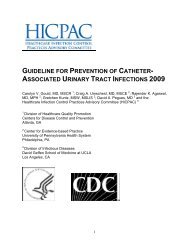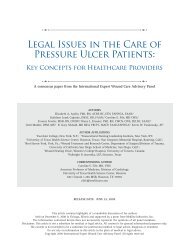SECT2.05 - Recommended Practices for Electrosurgery - Medline
SECT2.05 - Recommended Practices for Electrosurgery - Medline
SECT2.05 - Recommended Practices for Electrosurgery - Medline
- No tags were found...
Create successful ePaper yourself
Turn your PDF publications into a flip-book with our unique Google optimized e-Paper software.
RP: <strong>Electrosurgery</strong>(eg, oxygen and nitrous oxide) underthe drapes, to allow air circulation, andto dilute the additional oxygen. 16,47,48IV.n.3. The active electrode should be used asfar from the oxygen source as possible.Personnel should be prepared to immediatelyextinguish flames should they occur. 16,47A small fire can progress to a life threateningemergency of a large fire in seconds.ESUs are a potential ignition sourceand a common cause of surgical fires andpatient injury. 28IV.o.1. Nonflammable material (eg, wet towel,sterile saline, water) should be availableon the sterile field to extinguishthe fire. 16,28Recommendation Vmonopolar electrosurgery is used, a dispersiveelectrode should be used in a manner thatminimizes the potential <strong>for</strong> injuries.Patient skin injuries at the dispersive electrode sitemost reported ESU incidents. 2 Single use dispersiveelectrode burns are decreasing withimproved technology and the use of safety features.reports of electrosurgical burns has decreased50 to 100 per month in the 1970s to one to twomonth in 2007. 2The patient’s skin condition should beassessed and documented be<strong>for</strong>e and afterESU use.The most frequently reported patientinjury from electrosurgery has been tissuedamage (eg, burn) at the dispersive electrodesite. 2 Preoperative and postoperativeassessments are necessary to evaluate thepatient’s skin condition <strong>for</strong> possible injuries.Return-electrode contact quality monitoringshould be furnished on general purposeelectrosurgery units. 18The technology of return-electrode contactquality monitoring inhibits the output ofthe ESU if the return electrode is not in contactwith the patient and connected to theESU. Return-electrode contact quality monitoringconfirms that there is adequate contactbetween the return electrode and thepatient. An audible alarm and visual indicatorsignals the user of a misconnection. 2,18 V.b.1.V.c. Return-electrodeshouldqualitydetectsorpluggedV.c.1.V.d. DispersivewithandpatientV.e. AusedpersivenewadheredispersivetoskinV.f. Dispersivepriateinfant,cut,electroderentsurgicalV.g. Be<strong>for</strong>epersive–Dual-foil return electrodes should beused. 18Dual-foil return electrodes are necessary<strong>for</strong> contact quality monitoring. 18The return electrode contact qualitymonitoring system determines differencesin impedance through patient’stissue between the two surfaces. If theimpedance is too high as a result ofpoor contact, the alarm is triggered andthe ESU stops functioning. 2continuity monitoringbe used if return-electrode contactmonitoring is not available.Return-electrode continuity monitoringbreaks in the return-electrode corda misconnection (ie, the cord is notinto the ESU). 2,19If using return-electrode continuitymonitoring, a single-foil electrodeshould be used. 2electrodes should be compatiblethe ESU.Incompatibility of the electrosurgical unitthe dispersive electrode may result ininjury.single-use dispersive electrode should beonce and discarded. If a single-use dis-electrode must be repositioned, asingle-use electrode should be used. 23,56A reused single-use electrode may notproperly to the skin. Replacing theelectrode provides an opportunityexamine the electrode and the patient’scondition.electrodes should be an appro-size <strong>for</strong> the patient (eg, neonate,pediatric, adult) and not altered (eg,folded).Using the appropriately sized dispersivereduces the concentration of cur-and minimizes the potential <strong>for</strong> electro-injuries.the application of a single-use dis-electrodethe manufacturer’s expiration date shouldbe verified and the dispersive electrodeIV.o.Whenare theThefromperV.a.V.b.104Equipment and Product Safety2012 Perioperative Standards and <strong>Recommended</strong> <strong>Practices</strong>
















